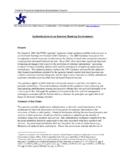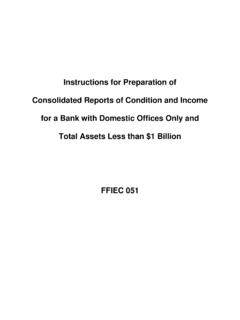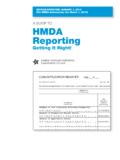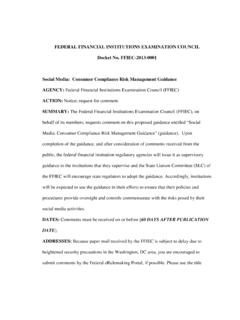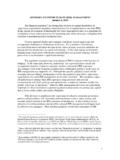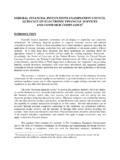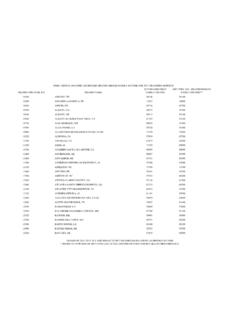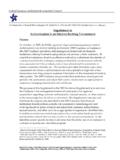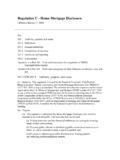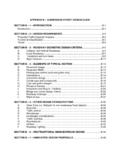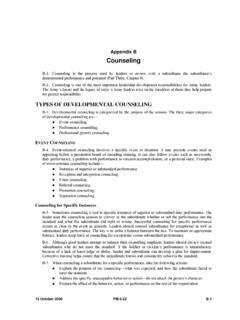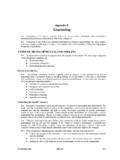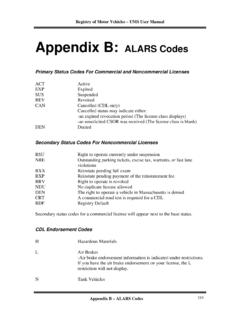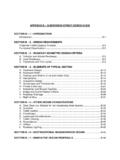Transcription of Appendix B: Mapping Cybersecurity Assessment …
1 Appendix B: Mapping Cybersecurity Assessment tool to NIST. Cybersecurity Framework In 2014, the National Institute of Standards and Technology (NIST) released a Cybersecurity Framework for all sectors. The following provides a Mapping of the FFIEC Cybersecurity Assessment tool ( Assessment ) to the statements included in the NIST Cybersecurity Framework. NIST reviewed and provided input on the Mapping to ensure consistency with Framework principles and to highlight the complementary nature of the two resources. As the Assessment is based on a number of declarative statements that address similar concepts across maturity levels, the Mapping references the first time the concept arises beginning with the lowest maturity level. As such, statements at higher levels of maturity may also map to the NIST. Cybersecurity Framework. References for the NIST Cybersecurity Framework are provided by page number and, if applicable, by the reference code given to the statement by NIST.
2 The Assessment declarative statements are referenced by location in the tool . Following the Mapping is the guide to the development of the reference codes for the Assessment tool . The Mapping is in the order of the NIST Cybersecurity Framework. NIST Cybersecurity Framework FFIEC Cybersecurity Assessment tool A clear understanding of the organization's business Accomplished by completing the Inherent Risk Profile drivers and security considerations specific to use of part of the Assessment . informational technology and industrial control systems. (p. 4). Describe current Cybersecurity posture (p. 4) Accomplished by completing the Cybersecurity Maturity part of the Assessment . Describe target state for Cybersecurity (p. 4) Accomplished if an institution implements the Assessment as described in the User's Guide. Identify and prioritize opportunities for improvement with Accomplished if an institution implements the the context of a continuous and repeatable process (p.)
3 Assessment as described in the User's Guide. 4). Assess progress toward the target state (p. 4) Accomplished if an institution implements the Assessment as described in the User's Guide. Communicate among internal and external stakeholders : Situational awareness materials are about Cybersecurity risk (p. 4) made available to employees when prompted by highly visible cyber events or by regulatory alerts. : Customer awareness materials are readily available ( , DHS' Cybersecurity Awareness Month materials). June 2015 1. FFIEC Cybersecurity Assessment tool Mapping Cybersecurity Assessment tool to NIST Cybersecurity Framework Risk-based approach to managing Cybersecurity risk (p. : A risk Assessment focused on 4) safeguarding customer information identifies reasonable and foreseeable internal and external threats, the likelihood and potential damage of threats and the sufficiency of policies, procedures and customer information systems.
4 : The risk Assessment identifies Internet- based systems and high-risk transactions that warrant additional authentication controls. : The risk Assessment is updated to address new technologies, products, services, and connections before deployment. Express a risk tolerance (p. 5) : The institution has a cyber risk appetite statement approved by the board or an appropriate board committee. Determine how to handle risk (mitigate, transfer, avoid, Accomplished by completing the Cybersecurity Maturity accept) (p. 5) part of the Assessment tool . Develop the organizational understanding to manage Accomplished by completing the Cybersecurity Maturity Cybersecurity risk to systems, assets, data and Domain 1, Assessment Factor Governance. capabilities (p. 8). Develop and implement the appropriate safeguards to Accomplished by completing the Cybersecurity Maturity ensure delivery of critical infrastructure services (p.)
5 8) Domain 3, Assessment Factor Preventative Controls. Develop and implement the appropriate activities to Accomplished by completing the Cybersecurity Maturity identify the occurrence of a Cybersecurity event. (p. 8) Domain 3, Assessment Factor Detective Controls, and Domain 5, Assessment Factor Detection, Response and Mitigation. Develop and implement the appropriate activities to take Accomplished by completing the Cybersecurity Maturity action regarding a detected Cybersecurity event. (p. 8) Domain 5, Assessment Factor Detection, Response and Mitigation and Assessment Factor Escalation and Reporting. Develop and implement the appropriate activities to Accomplished by completing the Cybersecurity Maturity maintain plans for resilience and to restore capabilities Domain 5, Assessment Factor Incident Resilience or services that were impaired due to a Cybersecurity Planning and Strategy.
6 Event. (p. 9). Tier 1: Partial NIST Cybersecurity Framework FFIEC Cybersecurity Assessment tool Cybersecurity risk management is not formalized and This falls below Baseline. risks are managed in an ad hoc and sometimes reactive manner. (p. 10). Prioritization of Cybersecurity activities may not be This falls below Baseline. directly informed by organizational risk objectives, the threat environment or business/mission requirements. (p. 10). June 2015 2. FFIEC Cybersecurity Assessment tool Mapping Cybersecurity Assessment tool to NIST Cybersecurity Framework NIST Cybersecurity Framework FFIEC Cybersecurity Assessment tool Limited awareness of Cybersecurity risk at the This falls below Baseline. organizational level. (p. 10). Organization-wide approach to managing Cybersecurity This falls below Baseline. risk has not been established. (p. 10).
7 Organization implements Cybersecurity risk This falls below Baseline. management on an irregular, case-by-case basis due to varied experience or information gained from outside sources. (p. 10). Organization may not have processes that enable This falls below Baseline. Cybersecurity information to be shared within the organization. (p. 10). Organization may not have the processes in place to This falls below Baseline participate in coordination or collaboration with other entities. (p. 10). Tier 2: Risk Informed NIST Cybersecurity Framework FFIEC Cybersecurity Assessment tool Risk management practices are approved by : An information security and business management but may not be established as continuity risk management function(s) exists within the organizational-wide policy. (p. 10) institution. Prioritization of Cybersecurity activities is directly : Threat information is used to enhance informed by organizational risk objectives, the threat internal risk management and controls.
8 Environment, or business/mission requirements. (p. 10). : The board or an appropriate board committee ensures management's annual Cybersecurity self- Assessment evaluates the institution's ability to meet its cyber risk management standards. : Management periodically reviews the Cybersecurity strategy to address evolving cyber threats and changes to the institution's inherent risk profile. There is an awareness of Cybersecurity risk at the : Information security risks are discussed in organizational level but an organization-wide approach management meetings when prompted by highly visible to managing Cybersecurity risk has not been cyber events or regulatory alerts. established. (p. 10). : Annual information security training is provided. : Management is provided Cybersecurity training relevant to their job responsibilities. Risk-informed, management-approved processes and : The risk management program procedures are defined and implemented, and staff has incorporates cyber risk identification, measurement, adequate resources to perform their Cybersecurity mitigation, monitoring and reporting.
9 Duties. (p. 10). : Staff with Cybersecurity responsibilities have the requisite qualifications to perform the necessary tasks of the position. June 2015 3. FFIEC Cybersecurity Assessment tool Mapping Cybersecurity Assessment tool to NIST Cybersecurity Framework Cybersecurity information is shared within the : Situational awareness materials are organization on an informal basis. (p. 10) made available to employees when prompted by highly visible cyber events or regulatory alerts. The organization knows its role in the larger ecosystem, : The Cybersecurity strategy identifies and but has not formalized its capabilities to interact and communicates the institution's role as a component of share information externally. (p. 10) critical infrastructure in the financial services industry. : The Cybersecurity strategy identifies and communicates the institution's role as it relates to other critical infrastructures.
10 : The institution belongs or subscribes to a threat and vulnerability information-sharing source(s). that provides information on threats ( , FS-ISAC, US- CERT). Tier 3: Repeatable NIST Cybersecurity Framework FFIEC Cybersecurity Assessment tool The organization's risk management practices are : The institution has policies commensurate formally approved and expressed as policy. (p. 10) with its risk and complexity that address the concepts of information technology risk management. Organizational Cybersecurity practices are regularly : A formal process is in place to update updated based on the application of risk management policies as the institution's inherent risk profile changes. processes to changes in business/mission requirements and a changing threat and technology landscape. (p. 10). There is an organization-wide approach to manage : Management links strategic Cybersecurity risk.
